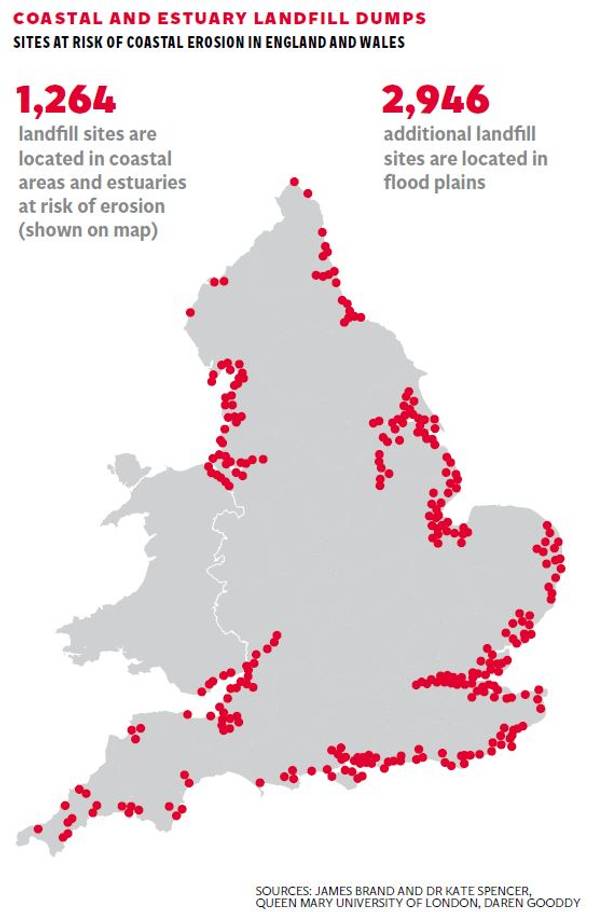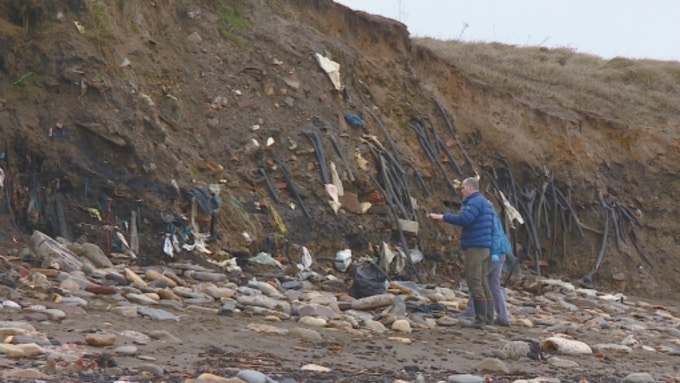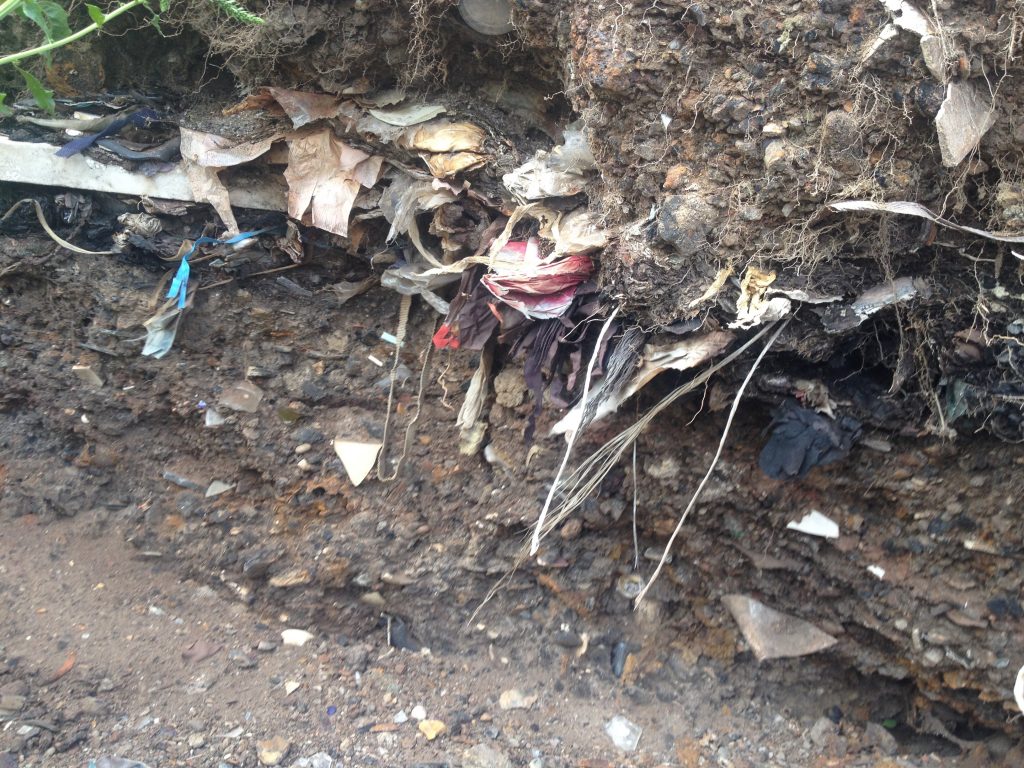 By Legal Futures’ Associate Future Climate Info
By Legal Futures’ Associate Future Climate Info
The UK has more than 21,000 historic landfills scattered across the country. 2,946 of these, according to analysis by the British Geological Survey (BGS), are located on flood plains. Many date back to 1890 and with few records kept of what went in them until EU regulations were introduced in the late 1990s, there are likely to be far more.
But with sea level rise comes a persistent and greater flood risk as, twice a day, landfills at coastal locations could release a cocktail of chemicals into our watercourses and beaches.

According to research carried out in August 2018 by Queen Mary University and the Environment Agency, there are more than 1,200 coastal landfill sites in England and one third of these are situated near ecological sites.
The research suggests 10 per cent of these historic landfills will start eroding in the next 40 years.
The vast majority of these were built with no coastal, riverbank or estuarine defences to protect their banks from eroding. Many could become compromised with spring tides and storm surges, creating real concerns about transmission to humans.
Lynemouth beach in Northumbria would be a fine strand of golden sand backed by imposing cliffs and the ideal place for families and dog walkers to take in the sea air. However, the beach also plays host to a historic landfill whose cliffs are eroding by waves causing industrial, colliery, household and fly-tipped waste to fall onto the beach and into the sea.
Northumberland County Council undertook land reclamation in the early 2000s, which involved cleaning up the beach and landscaping the cliff side, but now no longer has the funds to repair it again. The Government has said it can apply for a grant but it is ultimately the responsibility of the council.

Lynemouth Beach with former colliery landfill waste exposed along low cliffs. Picture courtesy of ITV News
The council understandably receive many complaints from many Lynemouth residents and the lack of funds means that there are ongoing and significant safety concerns, not least in the way the waste is being managed in relation to the local ecology.
In an interview with ITV News, the Council’s response was that “It would cost many, many millions of pounds to do (clear it up)…..and think the best that’s probably possible here is that we monitor it, we keep an eye on it, we remove the litter on a regular basis that is falling out of the cliff face onto the beach.
We try to prevent as much of that material as possible getting into the sea, but the prospect of being able to remove it all is very slim.”
DEFRA has no plans to fund a coastal erosion scheme in Lynemouth, but said that the Council can apply for a grant in aid to help contribute to such a project.
And these risks are showing themselves ever more widely.
The sea around the south coast has risen by approximately 10 centimetres since 1900 and this is well illustrated at Tilbury. The sandy Thames riverbank has been eroded with the remains of a former sea wall providing no defence.
Like Lynemouth Beach, at higher tides, the land has been stripped away to reveal layer upon layer of land-filled refuse.

Layers of exposed landfill waste exposed by higher tides on the Thames Estuary at Tilbury, Essex (Picture courtesy of Guy Shrubsole, Friends of the Earth).
“The research is alarming,” said Friends of the Earth Campaigner Guy Shrubsole, who has visited the Tilbury Landfill site. “Britain’s leaky landfills could turn out to be a toxic timebomb – and it’s clear that some are already leaching waste and chemicals into our watercourses.”
The study by Queen Mary University of the Essex coast found that the two most toxic waste-filled flood embankments screened (Hadleigh Marsh and Sea Wall in South Fambridge) pose the greatest overall risk of pollution.
This is due to their relatively high exposure and vulnerability to erosion, which means they are more likely to breach and release waste at a greater rate. This waste includes large quantities of harmful metals, such as lead, and polycyclic aromatic hydrocarbons (PAHs), which are carcinogenic.
The nature of coastal erosion and transmission of waste is that this can spread widely up and down the coast and into river estuaries on the flood and ebb tides. The potential spread and impact as a transmission area is incalculable.
Queen Mary University is working with the Environment Agency to produce a “vulnerability index” of the most at risk, undefended landfill sites in relation to flooding. This new risk screening assessment method could support coastal managers in identifying which historic coastal landfill sites pose the greatest pollution risk at a national scale for minimal cost using existing datasets.
The highest risk sites would then be prioritised for further investigation, including remedial works as appropriate. Any risk screening assessment provides a snapshot of the current highest risk sites. There would be a need to update this risk as other factors come into play – i.e. maintenance works, flood extents, e.g. due to climate change related sea level rise or changes to defences.
An Offending Landfill near your Site?
The Environment Agency is responsible maintaining the integrity of landfill sites, in relation to EU standards for new sites since they (and the Agency) were created. These regulations require landfill waste to be protected from their surroundings and from severe weather.
However, how can land or home buyers be sure that their site isn’t affected by an old, unprotected coastal landfill that could be broadcasting a contamination risk?
One of the very first considerations for clients’ property or land purchase is to see whether the messy neighbour downstream is going to reveal its secret past and affect asset values dramatically.
Future Climate Info’s environmental reports provide a comprehensive, yet concise and clear assessment of site history, potential for contamination and, as a result, follow-on options for more detailed testing or insurance provision.
For more information contact us on 01732 755180 or email info@futureclimateinfo.com










